Cassini captures clumping
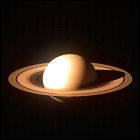 The Cassini spacecraft is close enough to Saturn to observe unusual transitory “clumps” in the planet’s ring system. First spotted by the Voyager space probes in the early 1980s, these clumps zip around Saturn’s outermost rings, following the direction of the planet’s own motion, but until now it hasn’t been possible to get close enough to study those clumps. Unlike the Voyagers, however, Cassini won’t be zipping past the planet at the speed of a bullet – it will enter an orbit around the planet in July and keep an eye on things.
The Cassini spacecraft is close enough to Saturn to observe unusual transitory “clumps” in the planet’s ring system. First spotted by the Voyager space probes in the early 1980s, these clumps zip around Saturn’s outermost rings, following the direction of the planet’s own motion, but until now it hasn’t been possible to get close enough to study those clumps. Unlike the Voyagers, however, Cassini won’t be zipping past the planet at the speed of a bullet – it will enter an orbit around the planet in July and keep an eye on things.
Rosetta lifts off
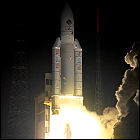 After years of delays that forced a rewrite of the entire mission plan, the European Space Agency launches the Rosetta unmanned space probe on a looping, ten-year journey through the solar system that will hopefully take it to a rendezvous with Comet 67/P Churyumov–Gerasimenko in ten years. The mission plan calls for Rosetta to orbit the comet and release a small lander, Philae, to descend to its surface. In the intervening years, Rosetta will also have opportunities to study Mars and various asteroids as it passes by them. Rosetta’s mission profile is similar to that of NASA’s cancelled 1990s CRAF (Comet Rendezvous / Asteroid Flyby) mission.
After years of delays that forced a rewrite of the entire mission plan, the European Space Agency launches the Rosetta unmanned space probe on a looping, ten-year journey through the solar system that will hopefully take it to a rendezvous with Comet 67/P Churyumov–Gerasimenko in ten years. The mission plan calls for Rosetta to orbit the comet and release a small lander, Philae, to descend to its surface. In the intervening years, Rosetta will also have opportunities to study Mars and various asteroids as it passes by them. Rosetta’s mission profile is similar to that of NASA’s cancelled 1990s CRAF (Comet Rendezvous / Asteroid Flyby) mission.
Opportunity lands on Mars
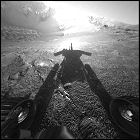 The Opportunity rover, identical to Spirit, lands on schedule and on target in Mars’ Meridiani Planum region, but initial readings from the surface of Mars indicate that the landing pod containing Opportunity has come to rest on its side. Telemetry signals from Opportunity announce that the the rover has arrived safely and intact, ready to begin its mission, and the opening of the landing vehicle returns Opportunity to its intended upright position. As with Spirit, Opportunity will remain on its landing platform for several days undergoing a series of diagnostic tests before rolling off to the Martian surface for independent exploration, and engineers are keeping a close eye out for signs of a computer problem that has plagued Spirit for several days.
The Opportunity rover, identical to Spirit, lands on schedule and on target in Mars’ Meridiani Planum region, but initial readings from the surface of Mars indicate that the landing pod containing Opportunity has come to rest on its side. Telemetry signals from Opportunity announce that the the rover has arrived safely and intact, ready to begin its mission, and the opening of the landing vehicle returns Opportunity to its intended upright position. As with Spirit, Opportunity will remain on its landing platform for several days undergoing a series of diagnostic tests before rolling off to the Martian surface for independent exploration, and engineers are keeping a close eye out for signs of a computer problem that has plagued Spirit for several days.
Spirit’s murky memory
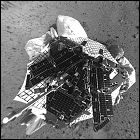 JPL engineers begin experiencing severe difficulty communicating with the Spirit Mars rover, which had successfully rolled off of its landing platform the previous week. Just as the rover is ready to begin its travels on the surface of Mars, it stops communicating with Earth, or with any orbiting spacecraft overhead. A command is transmitted to force Spirit to report its condition, and the resulting telemetry indicates that the rover has been continuously rebooting its internal computer system. By the weekend, after worries and warnings that Spirit would probably never regain 100% functionality, JPL’s engineers re-establish communications and received enough diagnostic information to narrow the problem down to Spirit’s flash memory and handling software. Engineers soon resolve the problem, transmitting instructions to work around the potentially corrupted memory, and restoring Spirit so it can continue its exploration.
JPL engineers begin experiencing severe difficulty communicating with the Spirit Mars rover, which had successfully rolled off of its landing platform the previous week. Just as the rover is ready to begin its travels on the surface of Mars, it stops communicating with Earth, or with any orbiting spacecraft overhead. A command is transmitted to force Spirit to report its condition, and the resulting telemetry indicates that the rover has been continuously rebooting its internal computer system. By the weekend, after worries and warnings that Spirit would probably never regain 100% functionality, JPL’s engineers re-establish communications and received enough diagnostic information to narrow the problem down to Spirit’s flash memory and handling software. Engineers soon resolve the problem, transmitting instructions to work around the potentially corrupted memory, and restoring Spirit so it can continue its exploration.
Spirit lands on Mars
 The first of two new American Mars rovers lands successfully on the red planet. The Mars rover Spirit enters the Martian atmosphere (and cleaves a path right through a dust storm), deploying thick layers of airbags that allow it to bounce safely until landing upright. This is the same landing system employed by the Pathfinder mission in 1997, but the unmanned robot probe in this case is much more sophisticated. Among the primary scientific objectives of Spirit’s mission is to determine if water existed on the surface of Mars for a significant length of time. The Spirit rover will undergo a series of diagnostics and won’t begin its mobile mission for several days. Its identical twin, a rover named Opportunity, will land in three weeks.
The first of two new American Mars rovers lands successfully on the red planet. The Mars rover Spirit enters the Martian atmosphere (and cleaves a path right through a dust storm), deploying thick layers of airbags that allow it to bounce safely until landing upright. This is the same landing system employed by the Pathfinder mission in 1997, but the unmanned robot probe in this case is much more sophisticated. Among the primary scientific objectives of Spirit’s mission is to determine if water existed on the surface of Mars for a significant length of time. The Spirit rover will undergo a series of diagnostics and won’t begin its mobile mission for several days. Its identical twin, a rover named Opportunity, will land in three weeks.
2003 Robot Hall Of Fame inductees
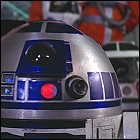
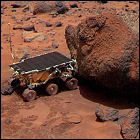 The first four inductees – two real and two fictional – are inducted into the Robot Hall Of Fame created by Carnegie Mellon University’s School of Computer Science.
The first four inductees – two real and two fictional – are inducted into the Robot Hall Of Fame created by Carnegie Mellon University’s School of Computer Science.
- Unimate (1961, General Motors) – the first robotic arm used in car assembly
- HAL-9000 (1968, from 2001: a space odyssey)
- R2-D2 (1977, from Star Wars)
- Sojourner (1996, NASA) – the first successful Mars rover
The panel of judges in future years will pare down the number of nominations awarded to fictional creations. R2-D2 actor Kenny Baker and Douglas Rains, the voice actor behind HAL, are in attendance.
Galileo’s mission ends
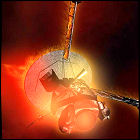 The mission of the unmanned space probe Galileo ends in the clouds of the giant planet Jupiter, which it has orbited for eight years. Even as Galileo plunges toward Jupiter, it detects and reports evidence of a thin ring sharing the orbit of the small moon Amalthea, and then disintegrates as it falls into Jupiter. NASA has opted to send Galileo to its destruction, rather than risking a collision with Europa, which may harbor some of the ingredients necessary for life and might be contaminated if Galileo impacted it; Galileo’s mission was extended three times, with the vehicle lasting six years longer than anticipated in the original mission plan’s estimates, which included for the harsh radiation environment of Jupiter as a factor in expecting only a two-year mission.
The mission of the unmanned space probe Galileo ends in the clouds of the giant planet Jupiter, which it has orbited for eight years. Even as Galileo plunges toward Jupiter, it detects and reports evidence of a thin ring sharing the orbit of the small moon Amalthea, and then disintegrates as it falls into Jupiter. NASA has opted to send Galileo to its destruction, rather than risking a collision with Europa, which may harbor some of the ingredients necessary for life and might be contaminated if Galileo impacted it; Galileo’s mission was extended three times, with the vehicle lasting six years longer than anticipated in the original mission plan’s estimates, which included for the harsh radiation environment of Jupiter as a factor in expecting only a two-year mission.
Uranus moons Hubble
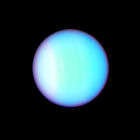 Astronomers using the Hubble Space Telescope discover two new moons of Uranus that eluded detection during Voyager 2’s 1986 flyby: Cupid and Mab. Both small, dark bodies that orbit closer to Uranus than any of the planet’s large satellites, Cupid and Mab raise the number of known Uranian satellites above 20. Mab’s orbit keeps it within the planet’s outermost ring, while Cupid’s orbit is only 500 miles further out than that of Belinda, one of the small moons discovered in 1986 by Voyager 2. Cupid is the tiniest of the inner moons of Uranus, roughly 11 miles in diameter.
Astronomers using the Hubble Space Telescope discover two new moons of Uranus that eluded detection during Voyager 2’s 1986 flyby: Cupid and Mab. Both small, dark bodies that orbit closer to Uranus than any of the planet’s large satellites, Cupid and Mab raise the number of known Uranian satellites above 20. Mab’s orbit keeps it within the planet’s outermost ring, while Cupid’s orbit is only 500 miles further out than that of Belinda, one of the small moons discovered in 1986 by Voyager 2. Cupid is the tiniest of the inner moons of Uranus, roughly 11 miles in diameter.
Hayabusa!
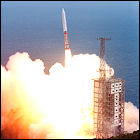 Japan’s Institute of Space and Astronautical Science (ISAS), launches the unmanned Hayabusa space probe on a mission to gather material from asteroid 25143 Itokawa. Intended to reach Itokawa in two years, and then return the asteroid samples to Earth in 2010, Hayabusa will also attempt to drop a small rover on Itokawa’s surface and will test an ion engine propulsion system. The name “Hayabusa” – translating to “peregrine falcon” – is only bestowed upon the spacecraft once it reaches space; prior to that, Hayabusa is known by its engineering designation, MUSES-C. A few months after Hayabusa’s launch, ISAS itself is renamed JAXA (the Japanese Aerospace Exploration Agency).
Japan’s Institute of Space and Astronautical Science (ISAS), launches the unmanned Hayabusa space probe on a mission to gather material from asteroid 25143 Itokawa. Intended to reach Itokawa in two years, and then return the asteroid samples to Earth in 2010, Hayabusa will also attempt to drop a small rover on Itokawa’s surface and will test an ion engine propulsion system. The name “Hayabusa” – translating to “peregrine falcon” – is only bestowed upon the spacecraft once it reaches space; prior to that, Hayabusa is known by its engineering designation, MUSES-C. A few months after Hayabusa’s launch, ISAS itself is renamed JAXA (the Japanese Aerospace Exploration Agency).
The sun that coughed
 Following up on observations from Earth-based telescopes, NASA’s Hubble Space Telescope is pointed toward the star V838 Monocerotis – an object of very little previous interest – to discover why it’s suddenly the brightest thing in the entire Milky Way Galaxy. What Hubble sees surprises scientists on the ground: a “shell” of matter surrounding the star, illuminated from within and expanding outward into space (actual photo sequence seen here). What astronomers had seen previously was the illumination of the dust cloud, which is much larger than the star itself. Scientists theorize that the expanding dust cloud is not an indication of a supernova, but a sign that V838 Monocerotis is expanding, expelling gas and then shrinking again. The star is over 20,000 light years from Earth.
Following up on observations from Earth-based telescopes, NASA’s Hubble Space Telescope is pointed toward the star V838 Monocerotis – an object of very little previous interest – to discover why it’s suddenly the brightest thing in the entire Milky Way Galaxy. What Hubble sees surprises scientists on the ground: a “shell” of matter surrounding the star, illuminated from within and expanding outward into space (actual photo sequence seen here). What astronomers had seen previously was the illumination of the dust cloud, which is much larger than the star itself. Scientists theorize that the expanding dust cloud is not an indication of a supernova, but a sign that V838 Monocerotis is expanding, expelling gas and then shrinking again. The star is over 20,000 light years from Earth.
The giant who melted
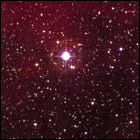 NASA’s Hubble Space Telescope makes an astonishing discovery while observing one of the first planets discovered beyond Earth’s solar system. The gas giant planet designated HD 209458b, orbiting the star HD 209458 in the constellation of Pegasus, 150 light years from Earth, is losing its atmosphere. Slightly larger than Jupiter, but locked into a dizzyingly tight orbit around its star (only 4,000,000 miles, with its “year” lasting less than half of an Earth week), HD 209458b’s atmosphere is boiling away into space thanks to the heat of the nearby star. This leads to a new exoplanet classification, “Hot Jupiters,” used to describe gas giants in similarly suicidal orbits. The core of HD 209458b will probably not last long once the last remnants of its atmosphere dissipate.
NASA’s Hubble Space Telescope makes an astonishing discovery while observing one of the first planets discovered beyond Earth’s solar system. The gas giant planet designated HD 209458b, orbiting the star HD 209458 in the constellation of Pegasus, 150 light years from Earth, is losing its atmosphere. Slightly larger than Jupiter, but locked into a dizzyingly tight orbit around its star (only 4,000,000 miles, with its “year” lasting less than half of an Earth week), HD 209458b’s atmosphere is boiling away into space thanks to the heat of the nearby star. This leads to a new exoplanet classification, “Hot Jupiters,” used to describe gas giants in similarly suicidal orbits. The core of HD 209458b will probably not last long once the last remnants of its atmosphere dissipate.
Galileo lives!
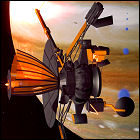 NASA and JPL ground controllers coax the radiation-damaged tape recorder built into the Galileo probe into working again, finally allowing several weeks worth of scientific data to be replayed to Earth. The damage was suffered during Galileo’s closest pass by Jupiter to study the tiny moon Amalthea the previous month. With layoffs looming for many of Galileo’s ground control staff in early 2003, this is Galileo’s last chance to relay its scientific findings back to Earth. It is on a trajectory that will end its mission by plunging into Jupiter in 2003.
NASA and JPL ground controllers coax the radiation-damaged tape recorder built into the Galileo probe into working again, finally allowing several weeks worth of scientific data to be replayed to Earth. The damage was suffered during Galileo’s closest pass by Jupiter to study the tiny moon Amalthea the previous month. With layoffs looming for many of Galileo’s ground control staff in early 2003, this is Galileo’s last chance to relay its scientific findings back to Earth. It is on a trajectory that will end its mission by plunging into Jupiter in 2003.
Galileo takes the Amalthea plunge
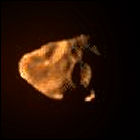 Nearing the end of its fuel supply, NASA’s Galileo probe passes one of Jupiter’s innermost moons, tiny, asteroid-like Amalthea, at a distance of less than 100 miles, coming closer to Jupiter and its belts of intense radiation than ever before. This final flyby of a Jovian moon is a punishing one for Galileo: the failure of Galileo’s main antenna dish after its 1989 launch has forced the robotic explorer to store its findings on tape for later playback to Earth at a low bit rate, but in this case roughly half of Galileo’s measurements of the highly charged environment near Jupiter are lost to radiation-induced failure of the tape recording system. The intense radiation also causes enough faults in Galileo’s main computer that the probe puts itself in a failsafe mode and “sleeps” until further commands are received from Earth hours later.
Nearing the end of its fuel supply, NASA’s Galileo probe passes one of Jupiter’s innermost moons, tiny, asteroid-like Amalthea, at a distance of less than 100 miles, coming closer to Jupiter and its belts of intense radiation than ever before. This final flyby of a Jovian moon is a punishing one for Galileo: the failure of Galileo’s main antenna dish after its 1989 launch has forced the robotic explorer to store its findings on tape for later playback to Earth at a low bit rate, but in this case roughly half of Galileo’s measurements of the highly charged environment near Jupiter are lost to radiation-induced failure of the tape recording system. The intense radiation also causes enough faults in Galileo’s main computer that the probe puts itself in a failsafe mode and “sleeps” until further commands are received from Earth hours later.
Quaoar
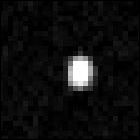 NASA’s Hubble Space Telescope spots an object beyond the orbit of Pluto, and approximately half the size of Pluto – the largest object discovered in the solar system in over 70 years. With a circular orbit that’s a billion miles further from the sun than Pluto, the body is determined to be approximately 800 miles in diameter. Quaoar is believed to be the largest Kuiper Belt object discovered to date, though its thunder will be stolen a few years later with the discovery of Eris and the demotion of Pluto to a dwarf planet.
NASA’s Hubble Space Telescope spots an object beyond the orbit of Pluto, and approximately half the size of Pluto – the largest object discovered in the solar system in over 70 years. With a circular orbit that’s a billion miles further from the sun than Pluto, the body is determined to be approximately 800 miles in diameter. Quaoar is believed to be the largest Kuiper Belt object discovered to date, though its thunder will be stolen a few years later with the discovery of Eris and the demotion of Pluto to a dwarf planet.
CONTOUR mission ends in pieces
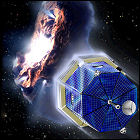 Launched on July 3rd, NASA’s comet-chasing CONTOUR (Comet Nucleus Tour) space probe fails to respond to an all-important, critically-timed command that would send it toward its first rendevous with a comet. As NASA engineers attempt to regain contact, high-powered telescopes pick up what may be a cloud of the $159,000,000 space probe’s debris as it settles into a leisurely orbit around the sun. A definitive cause for the failure of the CONTOUR mission is never found.
Launched on July 3rd, NASA’s comet-chasing CONTOUR (Comet Nucleus Tour) space probe fails to respond to an all-important, critically-timed command that would send it toward its first rendevous with a comet. As NASA engineers attempt to regain contact, high-powered telescopes pick up what may be a cloud of the $159,000,000 space probe’s debris as it settles into a leisurely orbit around the sun. A definitive cause for the failure of the CONTOUR mission is never found.
STS-109: Hubble’s new wings
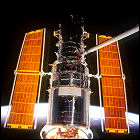 Space Shuttle Columbia lifts off on the 108th shuttle flight, the third Hubble Space Telescope servicing mission. Numerous enhancements are carried aboard the shuttle to replace existing parts on the decade-old orbiting telescope, including new cooling systems and a new set of solar power arrays. Aboard Columbia for her 27th flight are Commander Scott Altman, Pilot Duane Carey, Payload Commander John Grunsfeld, and mission specialists Nancy Currie, James Newman, Richard Linnehan and Michael Massimino.
Space Shuttle Columbia lifts off on the 108th shuttle flight, the third Hubble Space Telescope servicing mission. Numerous enhancements are carried aboard the shuttle to replace existing parts on the decade-old orbiting telescope, including new cooling systems and a new set of solar power arrays. Aboard Columbia for her 27th flight are Commander Scott Altman, Pilot Duane Carey, Payload Commander John Grunsfeld, and mission specialists Nancy Currie, James Newman, Richard Linnehan and Michael Massimino.
Space Shuttle Columbia makes her final landing at the end of this 11-day mission.
New Horizons to Pluto
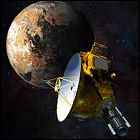 NASA announces that the New Horizons mission, proposed by a group of scientists and engineers from the cancelled Pluto-Kuiper Express mission, will go ahead to preparation, construction and launch sometime in 2006. Part of NASA’s new New Frontiers mission class, New Horizons promises significant scientific return from a never-before-explored region of the solar system while adhering to the “faster, better, cheaper” philosophy NASA has rallied around since the 1990s. Though this is the official green light for New Horizons to proceed, budget cutbacks at the Congressional level will threaten the mission for several years to come.
NASA announces that the New Horizons mission, proposed by a group of scientists and engineers from the cancelled Pluto-Kuiper Express mission, will go ahead to preparation, construction and launch sometime in 2006. Part of NASA’s new New Frontiers mission class, New Horizons promises significant scientific return from a never-before-explored region of the solar system while adhering to the “faster, better, cheaper” philosophy NASA has rallied around since the 1990s. Though this is the official green light for New Horizons to proceed, budget cutbacks at the Congressional level will threaten the mission for several years to come.
Galileo’s close look at Io’s volcanoes
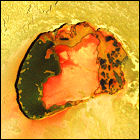 NASA/JPL’s Galileo unmanned space probe makes the closest flybys yet of Io, the volcanically hyperactive moon of Jupiter which made headlines when Voyager scientists spotted an eruption in 1980. The new images give the best view yet of Io’s inhospitable surface, including a volcanic crater, 47 miles across, named after the Brazilian god of thunder, Tupan Patera – an eye-searingly colorful region even in natural light.
NASA/JPL’s Galileo unmanned space probe makes the closest flybys yet of Io, the volcanically hyperactive moon of Jupiter which made headlines when Voyager scientists spotted an eruption in 1980. The new images give the best view yet of Io’s inhospitable surface, including a volcanic crater, 47 miles across, named after the Brazilian god of thunder, Tupan Patera – an eye-searingly colorful region even in natural light.
Mars Odyssey arrives at the red planet
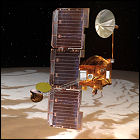 NASA’s 2001 Mars Odyssey probe reaches Mars and settles into an orbit which will gradually be corrected by aerobraking (using the friction of the planet’s atmosphere to slow the vehicle down). Unlike the Mars Surveyor mission, Odyssey does not contain a landing probe, but will instead look at the planet from orbit. Another unique feature of Odyssey’s mission plan is the fact that it won’t be shut down when its scientific investigation has come to an end; it will be left in Mars orbit to serve as a communications relay satellite for future missions.
NASA’s 2001 Mars Odyssey probe reaches Mars and settles into an orbit which will gradually be corrected by aerobraking (using the friction of the planet’s atmosphere to slow the vehicle down). Unlike the Mars Surveyor mission, Odyssey does not contain a landing probe, but will instead look at the planet from orbit. Another unique feature of Odyssey’s mission plan is the fact that it won’t be shut down when its scientific investigation has come to an end; it will be left in Mars orbit to serve as a communications relay satellite for future missions.
NASA launches its own Genesis Project
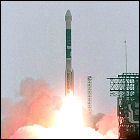 NASA and JPL launch the unmanned space probe Genesis to collect samples of the solar wind by exposing various materials from Earth to the solar wind and returning those materials to Earth – the first space mission to return samples from space since the Apollo moon missions – so the properties of the exposed samples can be compared to those of similar samples still on Earth. After nearly three years in deep space, Genesis will send a capsule loaded with these samples back to Earth, though its landing won’t exactly go as planned.
NASA and JPL launch the unmanned space probe Genesis to collect samples of the solar wind by exposing various materials from Earth to the solar wind and returning those materials to Earth – the first space mission to return samples from space since the Apollo moon missions – so the properties of the exposed samples can be compared to those of similar samples still on Earth. After nearly three years in deep space, Genesis will send a capsule loaded with these samples back to Earth, though its landing won’t exactly go as planned.
GOES-12 goes a little haywire
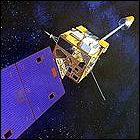 NOAA’s GOES-12 Geostationary Operational Environmental Satellite is launched from Cape Canaveral into geosynchronous orbit to monitor weather patterns over the United States. It will be held in reserve until 2003, when it will be moved to the GOES-EAST position to replace GOES-8, which is nearly out of fuel. Though GOES-11 has been in orbit longer than GOES-12, this satellite is activated first to use a solar imaging instrument (which will fail in 2006). Once in its active position, GOES-12 suffers from chronic thruster problems due to errors made during wiring of its primary and backup maneuvering thrusters; one outage will prove to be severe enough that the still-active GOES-10 must cover GOES-EAST coverage. In 2008, another thruster glitch will cause GOES-12 to temporarily lose all attitude control. In 2010, GOES-13 will replace GOES-12 in the GOES-EAST orbit thanks to the continued attitude control issues; GOES-12 remains in orbit as a backup.
NOAA’s GOES-12 Geostationary Operational Environmental Satellite is launched from Cape Canaveral into geosynchronous orbit to monitor weather patterns over the United States. It will be held in reserve until 2003, when it will be moved to the GOES-EAST position to replace GOES-8, which is nearly out of fuel. Though GOES-11 has been in orbit longer than GOES-12, this satellite is activated first to use a solar imaging instrument (which will fail in 2006). Once in its active position, GOES-12 suffers from chronic thruster problems due to errors made during wiring of its primary and backup maneuvering thrusters; one outage will prove to be severe enough that the still-active GOES-10 must cover GOES-EAST coverage. In 2008, another thruster glitch will cause GOES-12 to temporarily lose all attitude control. In 2010, GOES-13 will replace GOES-12 in the GOES-EAST orbit thanks to the continued attitude control issues; GOES-12 remains in orbit as a backup.
NEAR-Shoemaker signing off
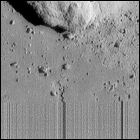 NASA’s NEAR-Shoemaker unmanned spacecraft, still on the surface of asteroid 433 Eros, sends its final signals to Earth before shutting down. Launched in 1996, NEAR-Shoemaker swung by asteroid 253 Mathilde before making its way to Eros via an Earth gravity assist maneuver. It orbited Eros for a year, having started its operations in close proximity to the asteroid a year later due to a technical problem in 1998 that nearly destroyed the space probe. Future asteroid missions such as Hayabusa and Dawn will refine the science of traveling to and studying asteroids.
NASA’s NEAR-Shoemaker unmanned spacecraft, still on the surface of asteroid 433 Eros, sends its final signals to Earth before shutting down. Launched in 1996, NEAR-Shoemaker swung by asteroid 253 Mathilde before making its way to Eros via an Earth gravity assist maneuver. It orbited Eros for a year, having started its operations in close proximity to the asteroid a year later due to a technical problem in 1998 that nearly destroyed the space probe. Future asteroid missions such as Hayabusa and Dawn will refine the science of traveling to and studying asteroids.
NEAR-Shoemaker lands on Eros
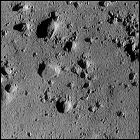 NASA’s NEAR-Shoemaker unmanned spacecraft gently touches down on the surface of asteroid 433 Eros, the first human-made space vehicle to land on such a body. Ground controllers are surprised to discover that NEAR-Shoemaker survives the landing, which was originally meant to end the mission; a two-week mission extension allows scientists to get readings from instruments that are now mere inches from Eros’ surface.
NASA’s NEAR-Shoemaker unmanned spacecraft gently touches down on the surface of asteroid 433 Eros, the first human-made space vehicle to land on such a body. Ground controllers are surprised to discover that NEAR-Shoemaker survives the landing, which was originally meant to end the mission; a two-week mission extension allows scientists to get readings from instruments that are now mere inches from Eros’ surface.
Hello, Himalia!
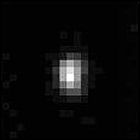 NASA releases a photo taken by the Cassini space probe as it passed by Jupiter and its complex system of satellites in December 2000, showing the first-ever view of the tiny moon Himalia, taken from a distance of 2.7 million miles. Non-spherical in shape, but estimated to be roughly 100 miles across its widest face, Himalia is believed to be an asteroid permanently captured into an inclined orbit of Jupiter. It was discovered in 1904 from Earth-based telescopes. The New Horizons space probe will also attempt to image Himalia in 2007. The sixth largest satellite of Jupiter, Himalia is the first of the planet’s outer satellites beyond the orbit of Callisto to be photographed by a passing spacecraft.
NASA releases a photo taken by the Cassini space probe as it passed by Jupiter and its complex system of satellites in December 2000, showing the first-ever view of the tiny moon Himalia, taken from a distance of 2.7 million miles. Non-spherical in shape, but estimated to be roughly 100 miles across its widest face, Himalia is believed to be an asteroid permanently captured into an inclined orbit of Jupiter. It was discovered in 1904 from Earth-based telescopes. The New Horizons space probe will also attempt to image Himalia in 2007. The sixth largest satellite of Jupiter, Himalia is the first of the planet’s outer satellites beyond the orbit of Callisto to be photographed by a passing spacecraft.
On to New Horizons
 In response to a NASA request for mission proposals a month earlier, Southwest Research Institute scientist Dr. Alan Stern and a group of other scientists and engineers who had been working on the now-cancelled Pluto-Kuiper Express mission submit a nearly-identical proposal to NASA for a Pluto/Kuiper Belt mission called New Horizons. Very much like Pluto-Kuiper Express, New Horizons calls for a single small spacecraft to launch early in the 21st century, and, after a gravity assist from a Jupiter flyby, a Pluto encounter 10-11 years after launch. Some of the program costs are streamlined in the new proposal to make this iteration of the long-delayed Pluto mission more appealing to NASA, although New Horizons would carry more scientific payload than any previously envisioned Pluto expedition. Another proposal, Pluto and Outer Solar System Explorer (POSSE), is also submitted to NASA.
In response to a NASA request for mission proposals a month earlier, Southwest Research Institute scientist Dr. Alan Stern and a group of other scientists and engineers who had been working on the now-cancelled Pluto-Kuiper Express mission submit a nearly-identical proposal to NASA for a Pluto/Kuiper Belt mission called New Horizons. Very much like Pluto-Kuiper Express, New Horizons calls for a single small spacecraft to launch early in the 21st century, and, after a gravity assist from a Jupiter flyby, a Pluto encounter 10-11 years after launch. Some of the program costs are streamlined in the new proposal to make this iteration of the long-delayed Pluto mission more appealing to NASA, although New Horizons would carry more scientific payload than any previously envisioned Pluto expedition. Another proposal, Pluto and Outer Solar System Explorer (POSSE), is also submitted to NASA.
Cassini swings by Jupiter
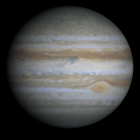 NASA’s Cassini space probe successfully completes a slingshot maneuver past Jupiter, a necessary milestone on the unmanned robot’s long journey to Saturn. While in the neighborhood, Cassini conducts tandem studies of Jupiter with the still-operational Galileo probe, which – despite numerous major malfunctions – has still survived three years longer in Jovian space than it was expected to. As large as Jupiter is, Cassini will still be lending its electronic eyes and ears to studies of the largest planet well into January. Cassini will reach Saturn’s neighborhood in 2004.
NASA’s Cassini space probe successfully completes a slingshot maneuver past Jupiter, a necessary milestone on the unmanned robot’s long journey to Saturn. While in the neighborhood, Cassini conducts tandem studies of Jupiter with the still-operational Galileo probe, which – despite numerous major malfunctions – has still survived three years longer in Jovian space than it was expected to. As large as Jupiter is, Cassini will still be lending its electronic eyes and ears to studies of the largest planet well into January. Cassini will reach Saturn’s neighborhood in 2004.
Pluto-Kuiper Express mission scuttled
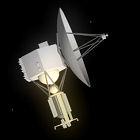 After four years of ballooning costs and launch weight, NASA brings work on the proposed Pluto-Kuiper Express mission to a stop, citing cost overruns and angering planetary scientists. The scientific community protests that, if a mission is not launched to reach Pluto by the year 2020, the tiny planet’s atmosphere will undergo a kind of reverse sublimation process, transitioning from a gas to a solid that rains down to Pluto’s surface. But with mission plans calling for a half-billion-dollar mission (originally budgeted for only $350 million), NASA pulls the plug, announcing that it will solicit new mission designs and plans from scientists around the world, even as advocates for the Pluto-Kuiper Express mission rally around the cancelled proposal.
After four years of ballooning costs and launch weight, NASA brings work on the proposed Pluto-Kuiper Express mission to a stop, citing cost overruns and angering planetary scientists. The scientific community protests that, if a mission is not launched to reach Pluto by the year 2020, the tiny planet’s atmosphere will undergo a kind of reverse sublimation process, transitioning from a gas to a solid that rains down to Pluto’s surface. But with mission plans calling for a half-billion-dollar mission (originally budgeted for only $350 million), NASA pulls the plug, announcing that it will solicit new mission designs and plans from scientists around the world, even as advocates for the Pluto-Kuiper Express mission rally around the cancelled proposal.
GOES-11 goes weather watching…after a while
 After over a year of launch delays, NOAA’s GOES-11 Geostationary Operational Environmental Satellite is launched from Cape Canaveral into geosynchronous orbit to monitor weather patterns over the United States. It will be held in reserve until 2006, when it will be moved to the GOES-WEST position to replace GOES-10, which is nearly out of fuel. The longevity of its predecessor means that GOES-11 doesn’t begin its active daily weather-watching until a year after the end of its projected five-year design lifespan, and GOES-12 will actually go active before GOES-11. GOES-11 will remain in service through the end of 2011, when it will boost itself into a higher-than-geostationary “graveyard” orbit and shut down.
After over a year of launch delays, NOAA’s GOES-11 Geostationary Operational Environmental Satellite is launched from Cape Canaveral into geosynchronous orbit to monitor weather patterns over the United States. It will be held in reserve until 2006, when it will be moved to the GOES-WEST position to replace GOES-10, which is nearly out of fuel. The longevity of its predecessor means that GOES-11 doesn’t begin its active daily weather-watching until a year after the end of its projected five-year design lifespan, and GOES-12 will actually go active before GOES-11. GOES-11 will remain in service through the end of 2011, when it will boost itself into a higher-than-geostationary “graveyard” orbit and shut down.
NEAR gets a new name
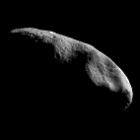 NASA’s NEAR (Near Earth Asteroid Rendezvous) unmanned spacecraft is officially renamed NEAR-Shoemaker, honoring Eugene Shoemaker, discoverer of multiple asteroids and comets, who died in 1997. Shoemaker had also put his geology skills to use in training Apollo astronauts after a medical diagnosis prevented him from joining the astronaut corps himself. NEAR-Shoemaker continues to orbit asteroid 433 Eros.
NASA’s NEAR (Near Earth Asteroid Rendezvous) unmanned spacecraft is officially renamed NEAR-Shoemaker, honoring Eugene Shoemaker, discoverer of multiple asteroids and comets, who died in 1997. Shoemaker had also put his geology skills to use in training Apollo astronauts after a medical diagnosis prevented him from joining the astronaut corps himself. NEAR-Shoemaker continues to orbit asteroid 433 Eros.
NEARer to Eros
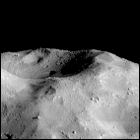 After orbiting the sun behind asteroid 433 Eros for a year since a failed thruster burn almost ended its mission, unmanned space probe NEAR (Near Earth Asteroid Rendezvous) fires its engines successfully, slowing itself to fall into orbit around Eros. During the weeks leading up to the orbital insertion maneuver, NEAR observed the space around Eros to ensure that no satellites existed with which it might collide. NEAR’s close study of Eros officially begins, and further maneuvers bring it into an ever-closer orbit around the asteroid.
After orbiting the sun behind asteroid 433 Eros for a year since a failed thruster burn almost ended its mission, unmanned space probe NEAR (Near Earth Asteroid Rendezvous) fires its engines successfully, slowing itself to fall into orbit around Eros. During the weeks leading up to the orbital insertion maneuver, NEAR observed the space around Eros to ensure that no satellites existed with which it might collide. NEAR’s close study of Eros officially begins, and further maneuvers bring it into an ever-closer orbit around the asteroid.